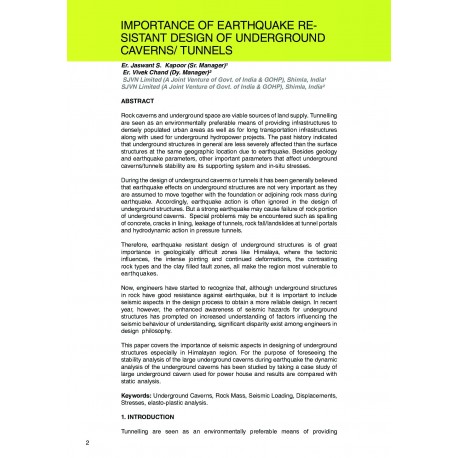Cart
0
0
No document
0,00 €
Total
Document successfully added to your shopping cart
Quantity
Total
There are 0 items in your cart.
There is 1 item in your cart.
Total documents
Total shipping
To be determined
Total
Search & filter
Search for a publication
Search & filter
Importance of earthquake re sistant design of underground caverns/ tunnels
3911_importance_of_earthquake_re
Rock caverns and underground space are viable sources of land supply. Tunnelling are seen as an environmentally preferable means of providing infrastructures to densely populated urban areas as well as for long transportation infrastructures along with used for underground hydropower projects. The past history indicated that underground structures in general are less severely affected than the surface structures at the same geographic location due to earthquake. Besides geology and earthquake parameters, other important parameters that affect underground caverns/tunnels stability are its supporting system and in-situ stresses. During the design of underground caverns or tunnels it has been generally believed that earthquake effects on underground structures are not very important as they are assumed to move together with the foundation or adjoining rock mass during earthquake. Accordingly, earthquake action is often ignored in the design of underground structures. But a strong earthquake may cause failure of rock portion of underground caverns. Special problems may be encountered such as spalling of concrete, cracks in lining, leakage of tunnels, rock fall/landslides at tunnel portals and hydrodynamic action in pressure tunnels. Therefore, earthquake resistant design of underground structures is of great importance in geologically difficult zones like Himalaya, where the tectonic influences, the intense jointing and continued deformations, the contrasting rock types and the clay filled fault zones, all make the region most vulnerable to earthquakes.Now, engineers have started to recognize that, although underground structures in rock have good resistance against earthquake, but it is important to include seismic aspects in the design process to obtain a more reliable design. In recent year, however, the enhanced awareness of seismic hazards for underground structures has prompted on increased understanding of factors influencing the seismic behaviour of understanding, significant disparity exist among engineers in design philosophy.This paper covers the importance of seismic aspects in designing of underground structures especially in Himalayan region. For the purpose of foreseeing the stability analysis of the large underground caverns during earthquake the dynamic analysis of the underground caverns has been studied by taking a case study of large underground cavern used for power house and results are compared with static analysis. Underground Caverns, Rock Mass, Seismic Loading, Displacements, Stresses, elasto-plastic analysis.




